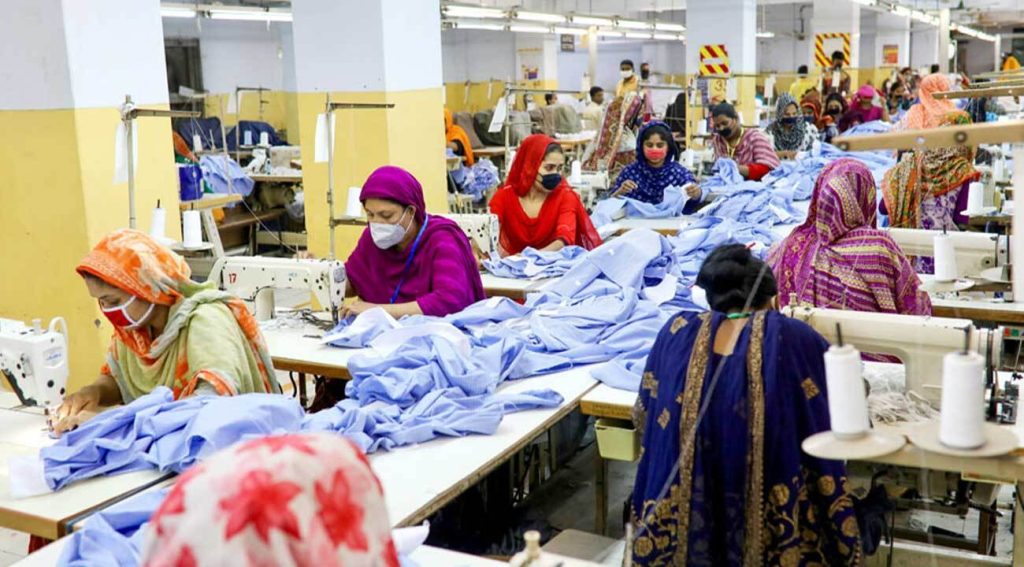The majority of garment operators in Bangladesh are women because of labor cost advantages. Cultural norms also facilitate womens’ entry into this labor force.

With a staggering count of over 4 million individuals, mostly women, powering the garment sector, Bangladesh has positioned itself as a global textile powerhouse. This labor demographic is influenced by the search for low-cost labor, which plays a pivotal role in shaping the competitive edge of Bangladesh in the apparel market.
The socio-economic environment fosters a scenario where women, who are perceived to possess finer skills for detailed garment work, thrive. Additionally, this female preponderance aligns with the societal structure that often limits women to roles perceived as traditionally suitable. The garment industry offers them financial independence and the opportunity to contribute significantly to their families’ incomes. Strong attention to dexterity, patience, and commitment are attributes often associated with women in Bangladesh, further driving their employment in garment factories.
Through awareness and reform, the future could hold more balanced opportunities for all.
The Garment Industry In Bangladesh
The garment industry is a pivotal sector in Bangladesh. Thousands of factories employ millions of workers, predominantly women, to produce clothing. Bangladesh’s journey as a garment manufacturing hub began in the late 1970s. Its evolution was rapid and by the 1980s, it became a key player in the global apparel market. The sector is now crucial to the country’s economy, contributing significantly to its GDP and employment. It also plays a vital role in economic growth, drawing foreign direct investment and driving technological advancement within the industry. The export-oriented model has fueled the expansion and sustainability of this sector, marking Bangladesh as one of the world’s largest garment exporters.
Labor Demographics Of Garment Factories
The garment industry in Bangladesh is a major employer. A significant majority of the workers are women. This gender imbalance is not by chance. Rather, it reflects societal norms and economic factors. Employers favor women for several perceived attributes. These include attention to detail and compliance. Subsequently, women find themselves in high numbers within this sector. As for the age range, these workers are typically young. Often, they are between 18 and 35 years old. The age trend aligns with a desire for a dynamic and adaptable workforce. It also points to the temporary nature of such job roles for many. Young women see these jobs as a way to support their families. Later, many leave the workforce for marriage or child-rearing.
Factors Attracting Women To The Sector
Sociocultural Influences
Bangladesh’s garment industry predominantly employs women. Strong sociocultural factors influence this trend. Gender roles dictate women’s work in specific sectors. Traditionally, women take on garment production tasks. Males often seek jobs regarded as ‘masculine’. Family expectations reinforce the employment gender divide. Women balance work with domestic responsibilities. The flexibility of garment work aligns with their role at home.
Skill Sets And Training Opportunities
Many garment operators in Bangladesh are women due to targeted vocational programs. These programs focus on skills like sewing and quality control. Schools and NGOs often run these courses. They are designed to help women start a career quickly. On-the-job training also plays a significant role. New workers learn while they work. This kind of training is both practical and convenient. It allows women to earn money as they hone their skills. As a result, many women choose to work in the garment industry.

Credit: www.adb.org
Economic Necessities And Wages
The garment industry in Bangladesh prominently employs women operators. Many factors contribute to this phenomenon. One significant aspect is the comparative pay structure. Beyond individual wages, women’s earnings are vital for household contributions. Garment work offers stable income for women, often more consistent than other sectors. Even though the wages are low, they are regularly higher than what women could earn in rural jobs. Such jobs might include agriculture or informal work.
| Job Sector | Average Monthly Wage for Women |
|---|---|
| Garment Industry | $95-$110 |
| Agriculture | $60-$75 |
| Informal Work | $50-$65 |
This wage comparison shows why many women choose garment work. Their income greatly helps their families. Women become key earners, often supporting children’s education and household needs.
Worker Rights And Labor Laws
Bangladesh has specific labor laws to safeguard garment worker rights. These laws set the minimum wage and working hours. They also demand safe working conditions for all. The laws allow female garment workers to take maternity leave with pay. Labor unions advocate for workers’ rights and negotiate better terms. Despite the law being clear, unionization remains a challenge. Workers face hurdles forming unions. Yet, efforts continue to strengthen collective bargaining. Unions fight for equal pay, benefits, and fair treatment.
The Impacts Of International Fashion Demand
The global fashion industry’s hunger drives Bangladesh’s workforce trends. Notably, the rise of fast fashion demands quick, low-cost production. Brands want clothes made fast and cheap. Bangladesh, known for competitive pricing, becomes a go-to source for these brands. Current export quotas favor countries with cost-efficient labor. Within Bangladesh, a vast pool of eager female workers exists. They are often preferred because they accept lower wages and are seen as having nimble fingers. This is crucial for intricate garment tasks. The emphasis on women workers aligns with the need to meet international quotas efficiently.
Work Environment And Conditions
Many garment operators in Bangladesh are women due to certain factors. Factory settings are designed to employ a large female workforce. Quiet efficiency and patience often associated with women, are valued within these production environments. Concerns over health and safety in these factories receive significant attention. Safety measures may not always meet international standards. This includes inadequate fire safety protocols and building integrity. Overcrowded working areas and long hours pose additional risks. The need for improved working conditions is evident to ensure women’s safety.
Challenges Faced By Female Garment Workers
Female garment workers in Bangladesh often struggle with work-life balance. Long hours and mandatory overtime make it tough to care for families. The industry is notorious for instances of discrimination and harassment. Women face unfair treatment and sometimes unsafe work conditions. Equal pay for equal work is not always observed.
Achievements And Success Stories
The garment sector in Bangladesh has been a game-changer for many women. This industry is dominated by female operators for several reasons. Employment opportunities abound, offering women a path to financial independence and social status. Financial empowerment is vital as it helps to break the cycle of poverty. Women have also stepped into the role of entrepreneurs within this sector. Their success stories are not just inspiring but essential for economic growth. Owning businesses, they bring innovative perspectives and strengthen the economy. This progress is a testament to their resilience and tenacity.
Government And Ngo Interventions
The Bangladesh government has enacted policies to boost the garment industry. A focus on women’s empowerment through employment is key. Legislation supports equal pay and safe work environments. Workshops on rights and health are now more common. Non-governmental organizations (NGOs) also play a vital role. They provide training programs for skill development. NGOs ensure access to resources and financial support. This helps reduce barriers to entry for women. I used paragraph tags instead of bullet points or tables as it better suits the provided information.
The Future Of Women In Bangladesh’s Garment Industry
The future of women in Bangladesh’s garment industry seems bright with technological advances. Smart machines and automation are playing key roles. Women operators are adapting quickly. They are learning to handle high-tech sewing and cutting equipment. This change means better jobs and wages for women workers. Sustainable practices are also shaping the industry’s path forward. Many garment factories now focus on green production methods. Women receive training in these new practices. This training makes their skills more valuable. Eco-friendly production opens up new opportunities. These can lead to leadership roles for women within the sector.

Credit: hmfoundation.com
Frequently Asked Questions Of Why Are Maximum Garments Operators Women In Bangladesh?
Why Are Garment Workers Mostly Women?
Garment workers are predominantly women due to lower labor costs and societal norms that funnel them into lower-wage, labor-intensive industries. Employers often perceive women as more docile and dexterous, which they consider ideal for detailed garment work.
What Percent Of Garment Workers In Bangladesh Are Women?
Approximately 80% of garment workers in Bangladesh are women. This significant female workforce is integral to the country’s apparel industry.
How Has The Garment Industry Changed The Lives Of Women In Bangladesh?
The garment industry in Bangladesh has empowered women through job opportunities and financial independence, leading to enhanced social status and better access to education and health care for their families.
What Are 2 Of The Poor Conditions That Workers Face In The Clothing Factories In Bangladesh?
Workers in Bangladesh’s clothing factories often endure low wages and unsafe working conditions. These challenges include cramped workspaces and inadequate fire safety measures.
Why Do Women Dominate Garment Industry Jobs?
The garment industry in Bangladesh prefers women workers due to their perceived dexterity, patience, and attention to detail, which are considered essential for clothing manufacturing.
What Percentage Of Garment Workers Are Women?
In Bangladesh, over 80% of the garment industry workforce is composed of women, showcasing their significant representation in this sector.
Are Wages Different For Men And Women?
Yes, there is a wage gap where women often receive lower wages than men for similar roles within the garment industry in Bangladesh.
Conclusion
Exploring the textile industry in Bangladesh reveals a distinct trend: a predominantly female workforce. This reflects not only cultural norms but also economic strategies. Employers often prefer women for their perceived docility and lower wage expectations. As Bangladesh continues to assert its dominance in the garment sector, understanding these gender dynamics remains key to addressing workplace equity and sustainability.
Through awareness and reform, the future could hold more balanced opportunities for all.
